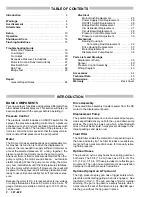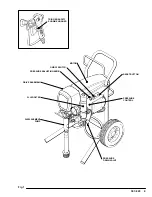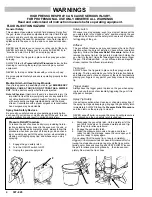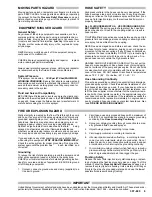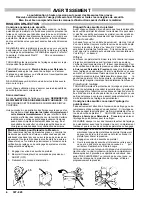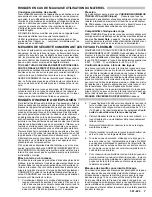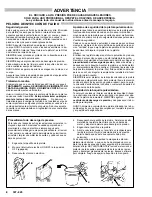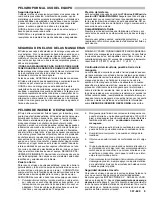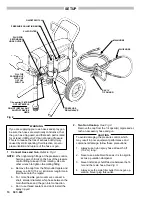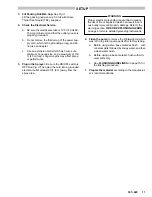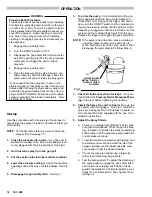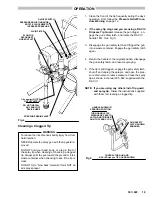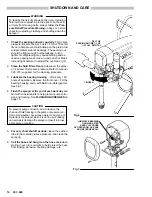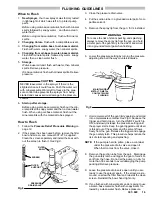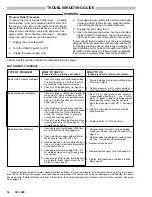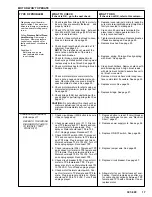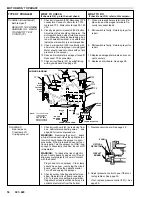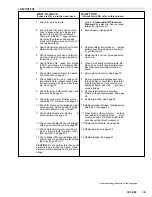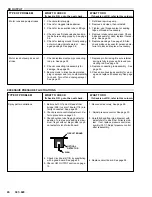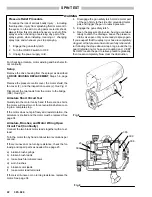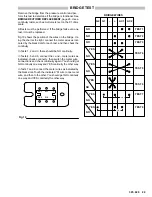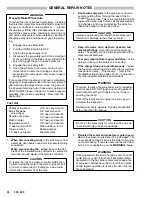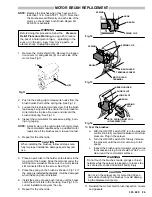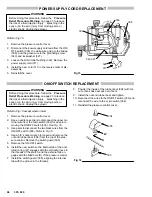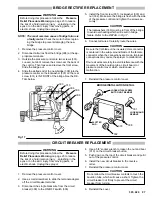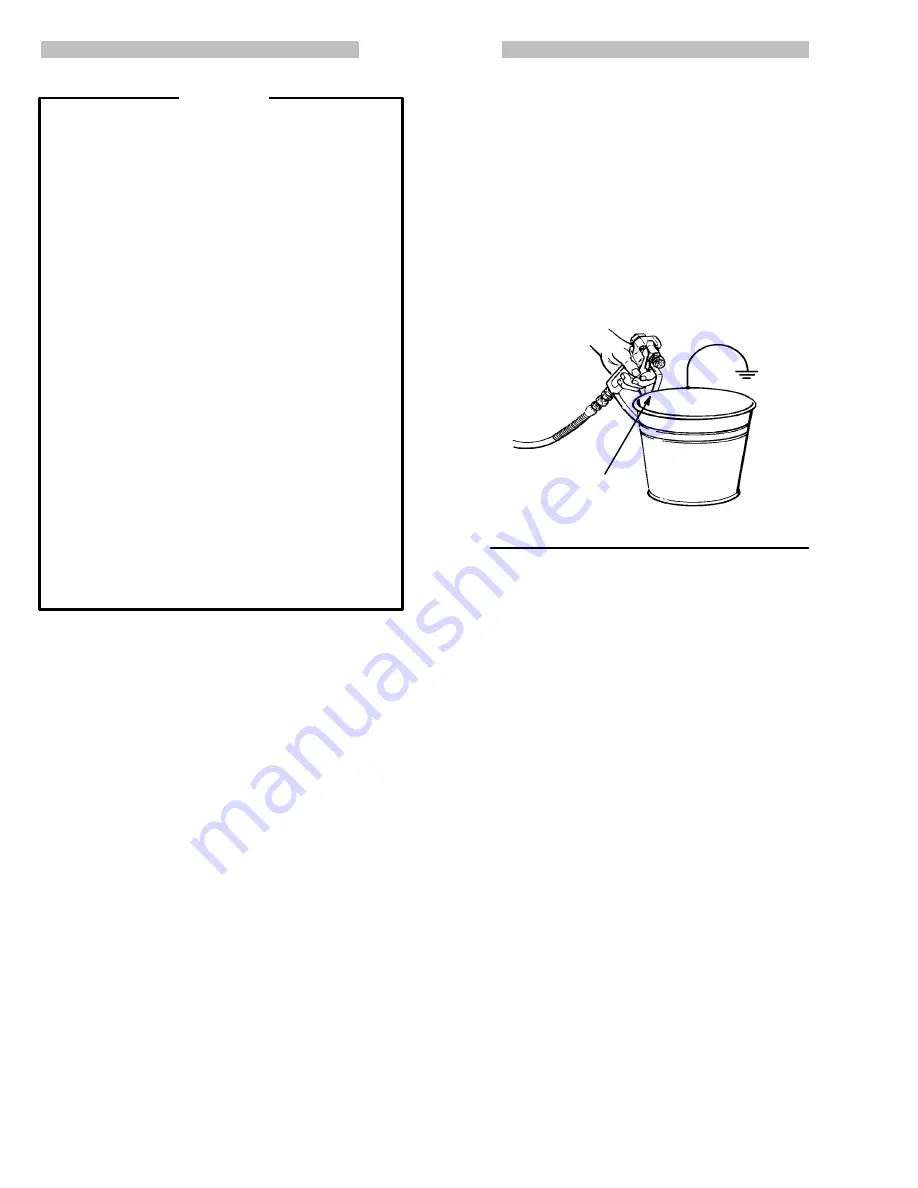
12
307–920
OPERATION
Pressure Relief Procedure
To reduce the risk of serious bodily injury, including
fluid injection, splashing fluid or solvent in the eyes
or on the skin, or injury from moving parts or electric
shock, always follow this procedure whenever you
shut off the sprayer , when checking or servicing
any part of the spray system, when installing,
cleaning or changing spray tips, and whenever you
stop spraying.
1. Engage the gun safety latch.
2. Turn the ON/OFF switch to OFF.
3. Disengage the gun safety latch. Hold a metal
part of the gun firmly to the side of a grounded
metal pail, and trigger the gun to relieve
pressure.
4. Engage the gun safety latch.
5. Open the pressure drain valve, having a con-
tainer ready to catch the drainage. Leave the
valve open until you are ready to spray again.
If you suspect that the spray tip or hose is com-
pletely clogged, or that pressure has not been fully
relieved after following the steps above, wrap a rag
around the tip guard retaining nut or hose end cou-
pling and VERY SLOWLY loosen the part to relieve
pressure gradually, then loosen completely . Now
clear the tip or hose.
WARNING
Startup
Use this procedure each time you start the sprayer to
help ensure the sprayer is ready to operate and that you
start it safely.
NOTE:
For the first time startup, be sure to flush the
sprayer first. See page 15.
1. Close the pressure drain valve.
If you have not in-
stalled a secondary hose, be sure the adapter is se-
curely plugged with the plug provided.
See Fig 4.
2. Don’t install a spray tip in the gun yet!
3
.
Put the suction tube into the material container
.
4. Lower the pressure setting
by turning the pressure
adjusting knob all the way counterclockwise.
See Fig
4.
5. Disengage the gun safety latch.
See Fig 7.
6. To prime the pump
, hold a metal part of the gun
firmly against and aimed into a metal waste con-
tainer.
See Fig 6. Squeeze the trigger and hold it
open, turn the ON/OFF switch to ON, and slowly in-
crease the pressure setting until the sprayer starts.
Keep the gun triggered until all air is forced out of the
system and the material flows freely from the gun.
Release the trigger and engage the gun safety latch.
NOTE:
If the pump is hard to prime, place a container
under the pressure drain valve and open it.
When fluid comes from the valve, close it. Then
disengage the gun safety latch follow Step 6.
Fig 3
MAINTAIN FIRM
METAL TO METAL
CONTACT WHEN
FLUSHING
7. Check all fluid connections for leaks
. If any are
found, follow the
Pressure Relief Procedure Warn-
ing
, to the left, before tightening connections.
8. Install the Spray Tip and Tip Guard.
Be sure the
gun safety latch is engaged.
See Fig 7. Install the
spray tip. If using the RAC IV DripLess tip guard, re-
fer to manual 307–848, supplied with the gun, for in-
stallation instructions.
9. Adjust the Spray Pattern
a. Check your material manufacturer’s spray pres-
sure recommendations. While the gun is spray-
ing, increase or decrease the pressure adjusting
knob setting until the pressure gauge reads the
correct pressure range.
b. To avoid excessive overspray and fogging, and
to decrease tip wear and extend the life of the
sprayer, always use the lowest possible pres-
sure needed to get the desired results.
c. If more coverage is needed, use a larger tip
rather than increasing the pressure.
d. Test the spray pattern. To adjust the direction of
the spray pattern, engage the gun safety latch
and loosen the retaining nut. Position the tip
guard horizontally for a horizontal pattern or ver-
tically for a vertical pattern. Then tighten the re-
taining nut.
Summary of Contents for 231-081
Page 47: ...47 307 920...


